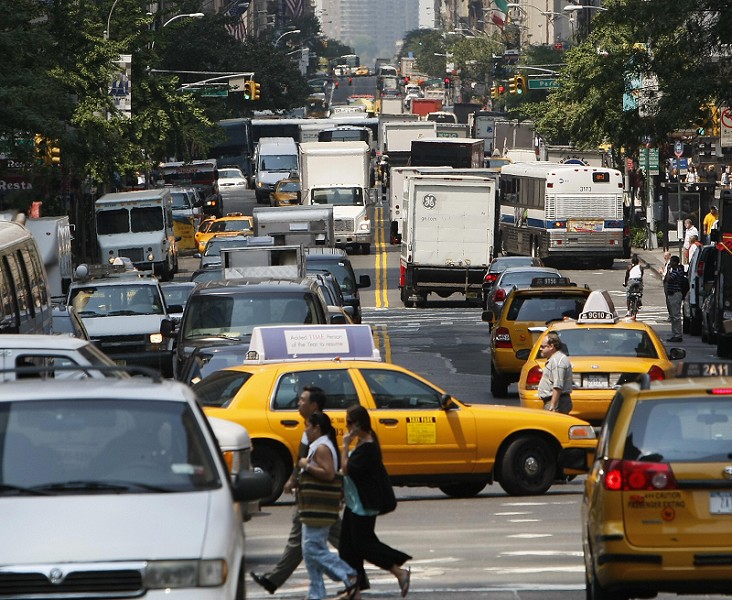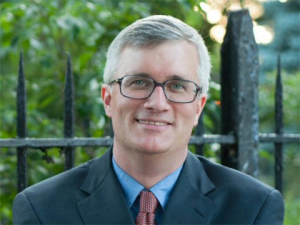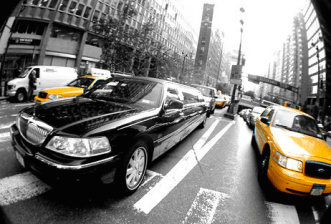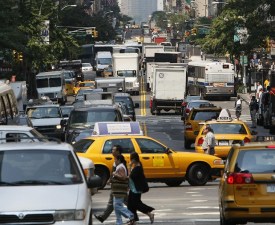Albany Didn’t Even Get the Taxi Fees Right
By omitting a cordon toll and charging taxis and Ubers per trip instead of per minute, Governor Cuomo and legislative leaders bungled their chance to reduce New York's most punishing traffic congestion.

It’s abundantly clear by now that the state budget negotiated by Governor Cuomo and legislative leaders didn’t even deliver a pale rendition of congestion pricing.
To recap, Albany enacted a $2.50 fee on each street-hail cab trip, a $2.75 per-trip fee for Uber and other app-based services, and a 75-cent fee for shared trips using services like Via or UberPool. The fees apply to trips that touch Manhattan below 96th Street. There’s no whiff of a cordon toll in the budget.
New Yorkers may not even notice the benefits. The proposed taxi and Uber surcharges will increase travel speeds in the Manhattan core by a measly 3.3 percent and yield, at most, $525 million a year in revenue — a mere one-third of what we would expect from the more robust recommendations of the Fix NYC panel, according to my modeling.
Why the puny results, given that for-hire vehicles account for half of all motorized mileage in the Manhattan core? Two reasons.
First, without cordon fees, any newfound space on the streets of the central business district invariably induces motorists to make more trips on the free bridges and across 60th Street. While this “rebound effect” won’t cancel out all of the traffic-reducing effects of the new surcharges, it will still add several thousand additional private cars to the Manhattan mix each day.
The second and bigger factor is the one-size-fits-all nature of the surcharges themselves. By design, these fees are the same for a long trip as a brief one. They’re also the same for a ride midday, when traffic is more intense and each additional vehicle brings traffic measurably closer to a standstill, as for a ride in the late evening, overnight, or early morning, when vehicle volumes are so light that additional trips cause little or no congestion.
With these built-in bugs, it’s no surprise that the benefits from the Albany surcharges are so meager. By comparison, I estimate that a system of for-hire vehicle charges geared to trip minutes within the taxi zone and also charging more during peak hours could boost daytime travel speeds in the Manhattan core by 5.4 percent, for the same overall cost as Albany’s surcharges. In effect, each dollar that yellow and Uber passengers would pony up under time-based surcharging would yield an almost two-thirds larger speed dividend than the flat surcharges.
This still wouldn’t be congestion pricing, but it might qualify as a prelude. So how would time-based surcharging work? Here’s an outline.
Rides in Ubers and other app-based services would be surcharged 30 cents for each minute in the “taxi zone” (Manhattan below 96th Street, roughly) with a fare. To dissuade Uber drivers from flooding Midtown while waiting for a ping, time spent cruising without a fare in the zone would also be surcharged, say at 6 cents a minute. These rates would be halved on weekday evenings and nights (8 p.m. – 6 a.m.) and throughout weekends and holidays. Estimated annual revenue: $305 million.
Yellow cabs would be surcharged $1.00 per minute of in-zone “wait time,” which TLC rate regulations define as times when the taxi is stuck at speeds under 6 mph. This would kick in primarily in highly congested areas and times, and it too would be reduced by half during off-peak times. Unlike Ubers, yellows wouldn’t be surcharged for cruising time, since the cap on their total number already acts as a brake against flooding the taxi zone. Estimated annual revenue: $220 million.
The combined revenue of $525 million (supplemented by $10 million in increased farebox revenue as more people opt for buses and subways) matches the revenue I calculate for the Albany surcharges, which break down as $275 million from Ubers and $250 million from yellows, plus $5 million from greater subway usage.
(My dollar amounts are somewhat greater than the figures from Albany, perhaps because I employ a more expansive definition of the taxi zone. All estimates here reflect the Albany surcharge of 75 cents per shared trip in Uber Pool, Lyft Line, and Via, even though they presently account for only around 5 percent of all app-based vehicles.)
With pressure remaining on the governor and the legislature to go the distance and authorize true congestion pricing with a cordon toll, they could at least swap out the blunt instrument of per-trip surcharges on taxis and Ubers for a more effective system of time-based surcharges. At least from a technical standpoint, these could become a gateway to eventually charging all vehicles — private cars and trucks as well as yellows and Ubers — on the basis of how much congestion they cause.


